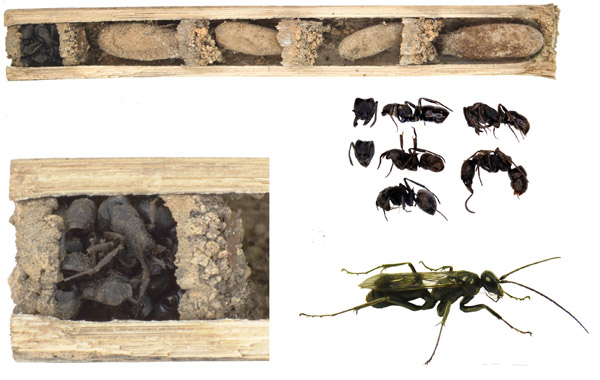
Adult female of the new wasp species, the bone-house wasp. Photo courtesy of Staab et al.
Deuteragenia ossarium) in a paper released today in PLOS ONE. But the reason it fills a nest chamber with dead ants is even more surprising: baby proofing.
“Our discovery demonstrates in an impressive way, what fascinating strategies of offspring-protection have evolved in the animal kingdom,” said lead author Michael Stabb with the University of Freiburg.
Here’s how this works: spider wasps (in the family Pompilidae) build large nests usually constructed out of plant debris, soil, and resin. Each nest contains several cells where the mother wasp lays her eggs. Once the nest is constructed and the eggs are laid, however, she abandons them, leaving them vulnerable to predation and parasites, such as parasitical wasps.
But the bone-house wasp from Southeast China has done something novel, which the authors describe as “a surprising nesting behavior that was previously unknown in the entire animal kingdom.” It builds a final outer layer cell around its brood in which it piles dead ants, sealing them up in a seeming bug-recreation of Poe’s “The Cask of Amontillado.” Yet the wasp doesn’t do this out of vengeance, but to better-safeguard its nest.

Close-up of the dead ant chamber. After killing the ants, the bone-house wasp encloses them in a cell. Photo courtesy of Staab et al.
“We propose two non-exclusive hypotheses: chemical camouflage and chemical defense by utilization of volatile chemical cues emanating from the dead ants,” the authors write.
In other words, even though they are dead, the ants still emit telltale chemical compounds. These compounds could potentially camouflage what’s really inside the nest, for example keeping parasitical wasps away. It could also scare away possible predators, since “most ant species ferociously defend their colonies against intruders,” the scientists explain, who discovered the behavior in the tropical forests of China’s Gutianshan National Nature Reserve.
The most commonly found ant in these murder-cells is the Pachycondyla astuta, which the research call “an aggressive, large-bodied, and common species in the study region that has a powerful sting.”
They hypothesize that the dead-house wasp targets this ant species not just because of its well-known ferocity, but also because of its abundance in the area: potential nest-raiders have likely already had bad encounters with this particular ant species. Moreover, as this is a big ant, the wasp only needs a few individuals to fill its macabre cell.
The scientists found that the construction of the ant bone house is, indeed, an effective strategy. In the nests they inspected the researchers never found the parasitic wasps that commonly invade other nests. Instead, the bone house wasp’s nests were “only attacked by parasitoids which entered the nest prior to the construction of the ant chamber.”
Sometimes, crime does pay.

Top: overview of nest showing brood cells closed off by the dead ant cell. Left: close-up of dead ant cell. Middle right: most ants in cells were Pachycondyla astuta, but other ants were used as well, including the bottom ant, which is a Polyrhachis illaudata. Bottom right: Adult female bone-house wasp. Photos courtesy of Staab et al. Click to enlarge.

Close-up of the ant cell adjacent to a brood cell. Photo courtesy of Staab et al.

Close-up of bone-house wasp face. Photo courtesy of Staab et al.
Citations:
- Staab M, Ohl M, Zhu C-D, Klein A-M (2014) A Unique Nest-Protection Strategy in a New Species of Spider Wasp. PLoS ONE 9(7): e101592. doi:10.1371/journal.pone.0101592
Related articles
Scientists discover carnivorous water rat in Indonesia, good example of convergent evolution

(06/19/2014) Researchers have discovered a new carnivorous water rat on the island of Sulawesi that’s so unique it represents an entirely new genus. They believe many more new rodent species await discovery in this relatively undisturbed part of Indonesia, but mining and other types of development may threaten vital habitat before it’s even surveyed.
Fly and wasp biodiversity in Peru linked to strange defense strategy

(06/18/2014) Entomologists working in Peru have revealed new and unprecedented layers of diversity amongst wasps and flies. The paper, published in the journal Science, also describes a unique phenomenon in which flies actually fight back and kill predatory parasitic wasps.
More is better: high bee biodiversity boosts crop yields

(06/12/2014) Scientists have discovered that blueberry plants visited by more diverse bee species increased their seed number, berry size and fruit set, and quickened their ripening time. They hope their findings encourage farmers to help support local wild bee communities.
Olinguito, tinkerbell, and a dragon: meet the top 10 new species of 2013

(05/22/2014) Out of around 18,000 new species described and named last year, scientists have highlighted ten in an effort to raise awareness about the imperiled biodiversity around us. Each species—from a teddy-bear-like carnivore in the Andes to a microbe that survives clean rooms where spaceships are built—stands out from the crowd for one reason or another.
The Harry Potter wasp: public votes to name new species after soul-sucking ghouls

(05/05/2014) Whether a die-hard Harry Potter fan or not, you probably know what dementors are. They were the guards of Azkaban —dark hooded evil beings that sucked the soul out of their victims, leaving them alive but ’empty-shelled.’ These fictional creatures now share their name with a new species of cockroach wasp, insects that turn cockroaches into zombies.

(04/09/2014) The notion of spiders using ants as bodyguards seems a bit contradictory, but that is exactly what occurs on the tropical forest floors of the Philippines. The jumping spider strategically nests within the vicinity of the aggressive Asian weaver ant as a defense tactic against its main predator, the spitting spider.